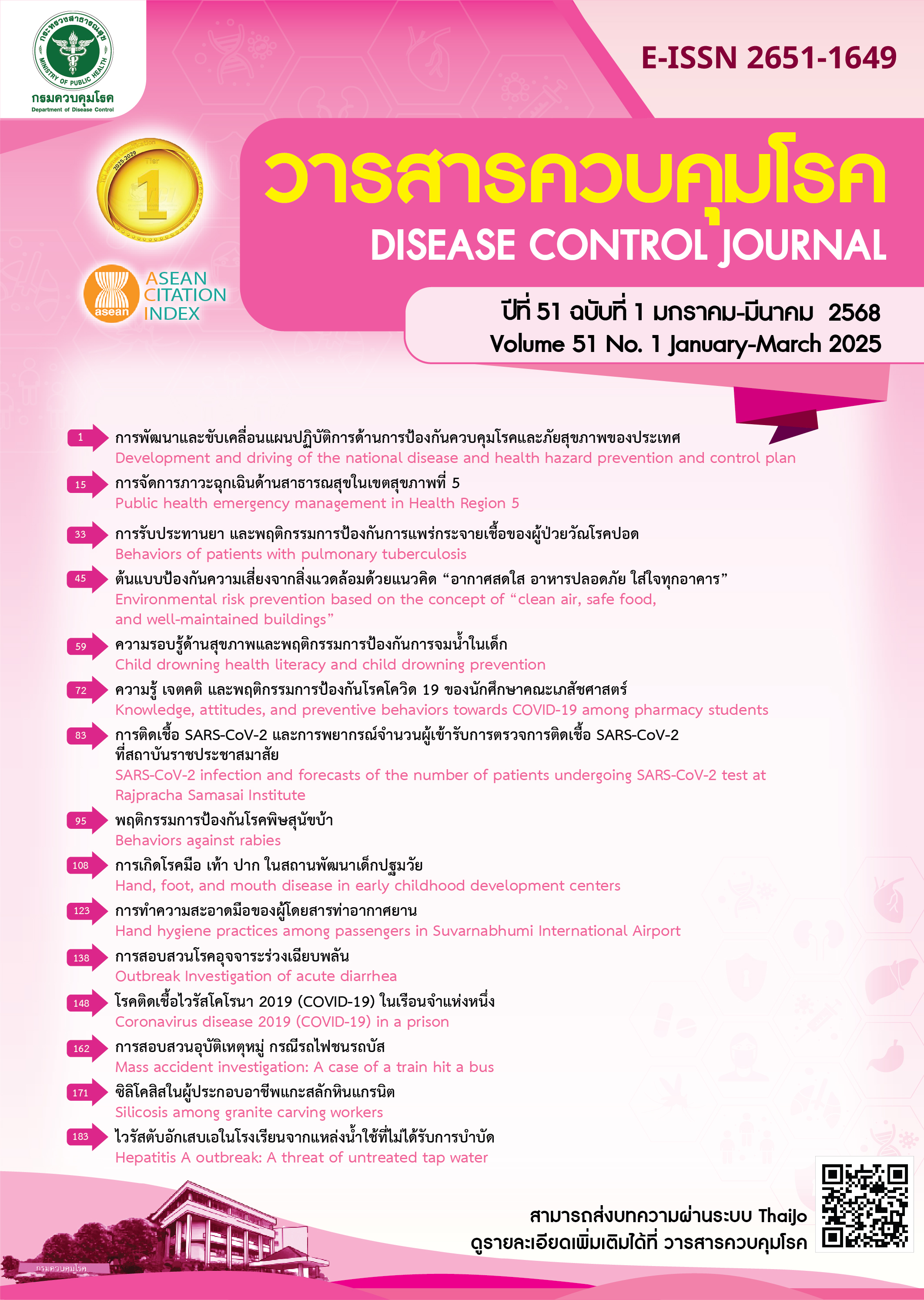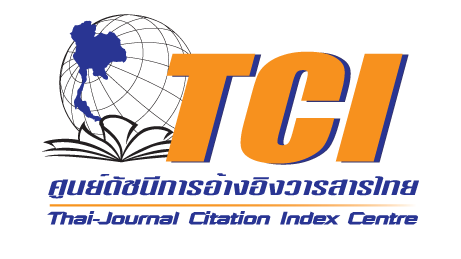ความรอบรู้ด้านสุขภาพและพฤติกรรมการป้องกันการจมน้ำในเด็กของครัวเรือน ในพื้นที่ตำบลเขาสามสิบ อำเภอเขาฉกรรจ์ จังหวัดสระแก้ว
DOI:
https://doi.org/10.14456/dcj.2025.5คำสำคัญ:
การจมน้ำในเด็ก, พฤติกรรมการป้องกันการจมน้ำ, ความรอบรู้ด้านสุขภาพ, ครัวเรือนบทคัดย่อ
การจมน้ำเป็นสาเหตุหลักของการเสียชีวิตในเด็กอายุต่ำกว่า 15 ปี งานวิจัยเชิงสำรวจนี้มีวัตถุประสงค์เพื่อศึกษาความรอบรู้ด้านสุขภาพในการป้องกันการจมน้ำในเด็กและปัจจัยที่มีความสัมพันธ์กับพฤติกรรมการป้องกันการจมน้ำในเด็กของครัวเรือน ของผู้แทนครัวเรือน ตำบลเขาสามสิบ อำเภอเขาฉกรรจ์ จังหวัดสระแก้ว โดยสัมภาษณ์ผู้แทนของครัวเรือนที่มีเด็กอายุต่ำกว่า 15 ปี จำนวน 291 ครัวเรือน เครื่องมือมีความตรงตามเนื้อหา individual content validity index: I-CVI และ scale content validity index: S-CVI มีค่า 0.83-0.97 และมีความเที่ยง (Cronbach’s alpha) ของแบบสัมภาษณ์ ในหมวดความรู้และทักษะการป้องกันการจมน้ำในเด็ก 0.72 และ 0.74 ความรอบรู้ด้านสุขภาพในการป้องกันการจมน้ำในเด็ก 0.82 และพฤติกรรมการป้องกันการจมน้ำในเด็กของครัวเรือน 0.74 กลุ่มตัวอย่างเป็นผู้แทนครัวเรือนที่มีเด็กอายุต่ำกว่า 15 ปี จำนวน 291 ครัวเรือน การวิเคราะห์ข้อมูลด้วยสถิติพรรณนาและการทดสอบไคสแควร์ ผลการศึกษา พบว่าผู้แทนครัวเรือนมีความรอบรู้การป้องกันการจมน้ำในระดับพอเพียง ร้อยละ 52.9 โดยทักษะการตัดสินใจ การนำไปใช้ และการเข้าถึงข้อมูลอยู่ในระดับพอเพียง ร้อยละ 53.6, 52.6 และ 51.9 ตามลำดับ ส่วนทักษะการเข้าใจและการไต่ถามอยู่ในระดับไม่พอเพียง ร้อยละ 52.9 และ 50.2 พฤติกรรมการป้องกันการจมน้ำในเด็กอยู่ในระดับดี ร้อยละ 80.5 แต่ความรู้ในการป้องกันการจมน้ำในเด็กอยู่ในระดับต่ำ ร้อยละ 83.8 ทักษะการป้องกันการจมน้ำในเด็กอยู่ในระดับดี ร้อยละ 85.1 ระดับการศึกษา และความรอบรู้ด้านสุขภาพในการป้องกันการจมน้ำในเด็กมีความสัมพันธ์กับพฤติกรรมป้องกันการจมน้ำในเด็กอย่างมีนัยสำคัญทางสถิติ (p-value<0.05) เพื่อป้องกันการจมน้ำและเสียชีวิตจากการจมน้ำควรจัดกิจกรรมส่งเสริมความรอบรู้ด้านสุขภาพและเสริมสร้างความรู้ในการช่วยฟื้นคืนชีพที่ถูกต้องแก่ประชาชนต่อไป
Downloads
References
World Health Organization. Preventing drowning: an implementation guide [Internet]. 2017 [cited 2023 Mar 22]. Available from: https://www.who.int/publications/i/item/9789241511933
Ministry of Public Health (TH), Department of Disease Control. Drowning Prevention Course for Program Manager [Internet]. [cited 2023 Mar 22]. Available from: https://e-learningdrowning .com/book-and-manual (in Thai)
Ministry of Public Health (TH), Department of Disease Control. Drowning Report [Internet]. [cited 2023 Mar 22]. Available from: https://dip.ddc.moph.go.th/satdrowning/ (in Thai)
Nutbeam D. Health literacy as a public health goal: A challenge for contemporary health education and communication strategies into the 21st century. Health Promotion International. 2000:15(3);259-67.
Ministry of Public Health (TH), Department of Disease Control. An Evaluation of Health Literacy in Prevention, Control Disease and Health Hazard of the Thai people during B.E.2022 [Internet]. [cited 2023 Mar 22]. Available from: https://datariskcom-ddc.moph.go.th/download/การประเมินความรอบรู้ด้-4/ (in Thai)
Farizan NH, Sutan R, Kulanthayan K. Effectiveness of “Be SAFE Drowning Prevention and Water Safety Booklet” intervention for parents and guardians. Iranian journal of public health. 2020;49(10):1921-30.
Hossain M, Mani KK, Sidik SM, Ks H, Fazlur Rahman A. Randomized controlled trial on drowning prevention for parents with children aged below five years in Bangladesh: a study protocol. BMC public health. 2015;15(1):1-7.
Peden AE, Franklin RC, Pearn JH. The prevention of child drowning: the causal factors and social determinants impacting fatalities in portable pools. Health Promot J Austral. 2020;31(2):184-91.
Farizan NH, Mani KK, Sutan R, Hod R. A concept paper on improving parental knowledge and practices on water safety and their children: a guide for drowning prevention. Int J Acad Res Bus Soc Sci. 2021;11(15):262-71.
Scarr J, Jagnoor J. Identifying opportunities for multisectoral action for drowning prevention: a scoping review. Inj Prev. 2022;28(6):585-594.
Leavy JE, Crawford G, Leaversuch F, Nimmo L, McCausland K, Jancey J. A review of drowning prevention interventions for children and young people in high, low and middle income countries. J Community Health. 2016;41(2):424-41.
Scarr J, Jagnoor J. Identifying opportunities for multisectoral action for drowning prevention: a scoping review. Inj Prev. 2022;28(6):585-94.
Wayne WD. Biostatistics: A foundation of analysis in health science. 7th ed. New York: John Wiley & Sons; 1999.
Bloom BS. Handbook on formative and summative evaluation of student learning. New York: McGraw-Hill book company; 1971.
Kaeodumkoeng K, Junhasobhaga J. A Development and Testing of Health Literacy on Disease Prevention and Control Assessment form for Public Health Officers. Romphruek Journal of the Humanities and Social Sciences of Krirk University. 2021;39(2):193-220. (in Thai)
Yupvattanapan P. Needs and Received Need Response among Mothers of Children Hostipitalized in Pediatric Intensive Care Unit at Maharaj Nakorn Chiang Mai Hospitals [dissertation]. Chiang Mai: Chiang Mai University; 1998. (in Thai)
Leavy JE, Crawford G, Leaversuch F, Nimmo L, McCausland K, Jancey J. A review of drowning prevention interventions for children and young people in high, low and middle income countries. Journal of community health. 2016;41(2):424-41.
Hossain M, Mani KK, Sidik SM, Ks H, Fazlur Rahman A. Randomized controlled trial on drowning prevention for parents with children aged below five years in Bangladesh: a study protocol. BMC public health. 2015;15(1):1-7.
Nanthamongkolchai S. Child Rearing in Thai Families Qualitative Study. Songkla Research and development office. Prince of Songkla University; 2004. (in Thai)
Wallis BA, Watt K, Franklin RC, Taylor M, Nixon JW, Kimble RM. Interventions associated with drowning prevention in children and adolescents: systematic literature review. Inj Prev. 2015;21(3):195-204.
Downloads
เผยแพร่แล้ว
How to Cite
ฉบับ
บท
License
Copyright (c) 2025 วารสารควบคุมโรค

This work is licensed under a Creative Commons Attribution-NonCommercial-NoDerivatives 4.0 International License.
บทความที่ลงพิมพ์ในวารสารควบคุมโรค ถือว่าเป็นผลงานทางวิชาการหรือการวิจัย และวิเคราะห์ตลอดจนเป็นความเห็นส่วนตัวของผู้เขียน ไม่ใช่ความเห็นของกรมควบคุมโรค ประเทศไทย หรือกองบรรณาธิการแต่ประการใด ผู้เขียนจำต้องรับผิดชอบต่อบทความของตน


.png)



